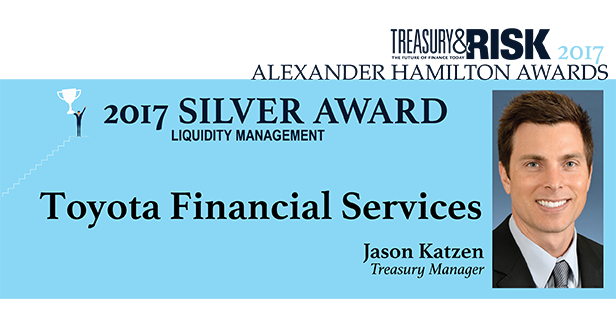 One of the core responsibilities of any treasury team, cash management may seem a fairly stable area of the business. But in today's evolving corporate environment, those managing cash flows have to be just as innovative as everyone else in the organization.
One of the core responsibilities of any treasury team, cash management may seem a fairly stable area of the business. But in today's evolving corporate environment, those managing cash flows have to be just as innovative as everyone else in the organization.
The regulatory environment is subject to change at any time, as evidenced by last year's money market reforms. The constantly changing technology landscape means companies need to constantly re-evaluate whether their solutions are still right for their organization. And in a function where staffing is almost always tight, optimizing efficiency remains an ongoing goal.
These pressures lead many treasury teams to embark on initiatives to improve their liquidity management practices. Two highly successful examples of these initiatives are this year's winners of the Alexander Hamilton Awards in Liquidity Management.
Recommended For You
Cash investment managers at Toyota Financial Services (TFS) used to take a fairly intuitive, one-off approach to investment decisions. When they wanted to start placing more of the company's short-term portfolio in corporate debt, senior leadership was open to the idea—if the company could develop a more systematic means of selecting investments. First, the treasury team established a regimented process for determining whether TFS should invest in a particular company. Then they developed a model that uses Bloomberg data to determine a forward-looking default probability.
Some of those who had been with TFS for years required some time to accept the new, systematic approach to cash management. But the results speak for themselves. "I was so used to working in a certain way, making decisions about prospective corporate investments based only on credit ratings, that I was much more comfortable sticking to the status quo," says Jason Katzen, treasury manager for Toyota Financial Services. "This project opened my eyes to the fact that there was a better way to manage cash."
Efficiency and consistency of decision-making were key benefits of TFS's project. They were also results of the award-winning liquidity management initiative at Hyundai Capital America. HCA utilizes an assortment of debt instruments, including commercial paper, revolvers, and conduit financing. "With our legacy process, deciding how and when to utilize a myriad of debt instruments for our short-term cash needs took quite a bit of time," says Hardy Gumnor, who manages the company's cash management group. "We needed a model that could go through all our funding options and help us make the optimal call."
 Treasury managers evaluated commercially available applications, but none met their needs. Thus, a team of business analysts and a financial engineer built a model in Microsoft Excel that automatically pulls in data from an assortment of sources and produces a funding recommendation. "We have the ability to override the model's decision, but getting that recommendation based on the current rate environment is a huge time-saver," Gumnor says.
Treasury managers evaluated commercially available applications, but none met their needs. Thus, a team of business analysts and a financial engineer built a model in Microsoft Excel that automatically pulls in data from an assortment of sources and produces a funding recommendation. "We have the ability to override the model's decision, but getting that recommendation based on the current rate environment is a huge time-saver," Gumnor says.
Both projects, and both organizations, demonstrate the enormous value that an innovative treasury team can offer its business. "To be successful in a modern treasury function, you have to be willing to adapt," says TFS's Katzen.
Congratulations to both companies!

Systematic Decision-Making for Short-Term Investments
Cash management is a key concern for the treasury team at Toyota Financial Services (TFS), the captive finance arm of Toyota Motor Corp. They oversee $8 billion to $10 billion in short-term investments at any given time, and they ensure that the company can always meet its funding needs by keeping these cash investments short. The weighted average maturity of the portfolio is two to three months, and all investments stay inside three years.
"We're not going too far out on the curve, and it's all high-quality, investment-grade credit," says Jason Katzen, treasury manager for Toyota Financial Services. "The portfolio is really there to act as a shock absorber for the business. As an example, we have around $30 billion in commercial paper, so about $350 million rolling off each day. Then our debt capital markets team is handling longer-term funding, so we're periodically helping them deal with term-debt maturities. And we have asset-backed securities, plus the everyday business needs of our dealerships. It's our job to manage the cash investments in a way that provides enough liquidity to supply all these cash flows."
Thus, Katzen and his team manage the short-term portfolio with more of a focus on liquidity and capital preservation than on total return. TFS also has a number of specific guidelines around cash investing, such as an upper limit on the proportion of short-term investments that can be in money market funds.
Beyond these guidelines, however, investment decisions used to be made in a highly decentralized manner. The company occasionally bought corporate debt, but these were one-off decisions driven by rating agency data. "It was pretty rare that we'd go over a detailed analysis of a corporate credit name or try to establish the relative value amongst different names," Katzen says. "Within the corporate investment policy, we would usually make gut decisions about which investments made the most sense." The portfolio was usually dominated by money market funds and time deposits.
But TFS paid a price for that approach. "There's a component of our portfolio that's focused on asset-liability matching," Katzen says. "To the extent that we were utilizing money market funds, we were shortening the weighted average maturity of the portfolio and increasing the cost of carry. So there was a real cost for forcing money to stay in the money market funds."
When last year's money fund reforms were on the horizon, TFS's debt capital markets team talked with the company's relationship banks, and with some of the investors in its direct commercial paper program, about what they were seeing in the marketplace. "They looked at how the changes would affect our investor mix on the funding side," Katzen says. "They tried to get a pulse on how many dollars were moving to separately managed accounts, and how many companies were going to 100 percent government funds. We had to figure out whether we needed to find more government investors or try to find others who wouldn't be impacted by the prime money market fund reforms."
The capital markets group determined that TFS would have a better assortment of options if it began investing routinely in corporate debt. This change would help the company bring assets in line with liabilities and sidestep some of the issues around the money fund reforms. Before approving this change, however, the company's fiscally conservative leaders wanted to see the process for selecting cash investments become more rules-based and systematic.
"Also, in true Toyota fashion, before launch we needed to work with our accounting and operations teams to make sure this was doable," Katzen says. "We're pretty thinly staffed on the operations side, and previously each time we would buy a corporate bond, they would have to manually set it up in our system. We needed to make sure the system had all the right fields for credit rating, type of security, etc., in order to make everything as streamlined as possible."
Led by Alec Small, who has since left the company, the team developed a process for evaluating the creditworthiness of a company whose debt TFS hadn't previously purchased. "First, an analyst puts together a qualitative write-up," Katzen says. "This describes, at a high level, what the company does, what its strengths and weaknesses are, and what its financials look like." Next, analysts pull together a quantitative report on the company. "The quantitative piece looks at some of the ratios that our research has indicated to be a good indicator of future corporate performance, such as sales to assets and cash flow to assets," Katzen explains. TFS's national manager of funding and liquidity, Nicholas Ro, reviews the qualitative and quantitative reports, then decides whether to grant approval to buy debt from the company.
 At the same time it was formalizing the process for approval of debt issuers, the project team also developed a model to help analysts on the team choose which approved companies to invest in. This model draws on credit default swap (CDS) and default risk (DRSK) data from Bloomberg to generate a forward-looking default probability. It also calculates the prospective investment's return per unit of risk, based on a benchmark risk-free rate of return. Finally, the model provides a recommendation of either "buy" or "do not buy."
At the same time it was formalizing the process for approval of debt issuers, the project team also developed a model to help analysts on the team choose which approved companies to invest in. This model draws on credit default swap (CDS) and default risk (DRSK) data from Bloomberg to generate a forward-looking default probability. It also calculates the prospective investment's return per unit of risk, based on a benchmark risk-free rate of return. Finally, the model provides a recommendation of either "buy" or "do not buy."
The sales and trading team further enhanced the model by collaborating with a group of UCLA students working on their master's degrees in financial engineering. Through six months of study of equity option volatilities, the team developed a real-time metric that effectively quantifies credit risk for a corporate issuer.
TFS's new, systematic approach to short-term investment management has provided several notable benefits. Consistency of decisions and efficiency are certainly among them. So is business continuity. "We're currently moving our headquarters to a new state," Katzen reports, "so we have quite a few people leaving and new faces coming in. There's still an art to investment selection, but if everybody uses the same regimented process in making their decisions, then our cash investment process is affected less by turnover."
Diversification is another plus. "We can move a little further out the yield curve," Katzen says. "The new process gives us the opportunity to buy floating-rate securities in some cases, as well. That's a capability we didn't have before, and it might be especially beneficial as interest rates move higher." In fact, relative to an internal measure of funding cost, returns on short-term investments have increased between 150 and 200 percent with the new regime.
Katzen emphasizes that this project shows the importance of being flexible. "I was so used to working in a certain way, making decisions about prospective corporate investments based only on credit ratings, that I was much more comfortable sticking to the status quo," he says. "This project opened my eyes to the fact that there was a better way to manage cash. Now I'm a firm believer in evidence-based investing that takes the emotion out of the process—and in keeping an open mind. To be successful in a modern treasury function, you have to be willing to adapt."

Modeling Short-Term Funding Best Practices
Hyundai Capital America (HCA) is the financial services captive of Hyundai in the United States. It's the organization that finances consumers' purchase or lease of a new Hyundai or Kia vehicle. The organization also provides financing to its dealerships. Depending on the needs of borrowers and whether any large debt issues are maturing in the near future, HCA's daily cash requirements may range anywhere from $50 million to $1.5 billion.
Funding these cash needs is a crucial responsibility of the treasury team, but HCA's process for selecting among multiple liquidity sources used to be extremely time-consuming. "We utilize a lot of different debt instruments simultaneously, including commercial paper, various revolvers, conduit financing, you name it," explains Hardy Gumnor, who manages the cash management group within HCA's treasury department. "With our legacy process, deciding how and when to utilize a myriad of debt instruments for our short-term cash needs took quite a bit of time. We didn't have all the relevant information consolidated, so a lot of disparate steps were involved in making every short-term funding decision. We needed a model that could go through all our funding options and help us make the optimal call."
HCA's cash management and capital markets teams also saw the opportunity to develop a more streamlined approach to scenario planning. The company's liquidity profile and funding mix are predicated on asset/liability committee (ALCO) principles, rating agency guidance, and business needs. As part of this process, HCA carefully manages its mix of secured vs. unsecured funding. The capital markets team needed to be able to quickly and easily determine what effect a new debt instrument, or a new allocation among instruments, would have on the corporate portfolio.
"Every time we ran a scenario test, we'd have to start all over again," Gumnor says. "This would require multiple spreadsheets doing different activities. There were a lot of duplicate entries across the different sheets, which opened the door to errors as well as inefficiencies. We decided to go back to the drawing board and develop not just a forecasting tool but a funding model that could do various types of analyses and more complex variance tracking. We wanted to be able to punch a button and have the model provide proper funding direction."
In evaluating the available packaged cash-forecasting products, HCA treasury discovered that their demands were fairly radical. "Your typical forecast is strictly focused on inflows and outflows, not on selecting among funding options," Gumnor explains. "I've worked in places where all short-term funding was done with a single debt instrument. In that case, all you need to get from your forecast is how much money you need, and for what period of time, so the typical forecasting tool is fine. But when you need to work with your capital markets and financial risk teams to make a decision, using an assortment of debt instruments concurrently, it's helpful to get more information out of your model."
Because they were not satisfied with any of the commercial applications available for modeling short-term funding decisions, the HCA team began evaluating their opportunities to create a tool in-house. "We decided to do this in Excel, using macros," Gumnor says. "We knew it was going to take some financial engineering. Fortunately, our staff had the right skills. Several business analysts and a financial engineer worked closely together to, first, develop a project plan and, second, communicate that plan to senior management."
The team created a complex and macro-dependent spreadsheet that pulls in data about the company's cash needs from reports coming out of the company's strategic planning and financial planning and analysis (FP&A) groups. It combines that information with interest rate data for various debt instruments HCA might use, which it acquires from Bloomberg. On top of these factors, the model takes into account the maturities and terms of the debt instruments, such as limitations on how much HCA can borrow.
"Now we hit a button, and all the right information is extracted from the source reports to populate our model," Gumnor says. "From there, it runs calculations and makes funding recommendations. We have the ability to override the model's decision, but getting that recommendation based on the current rate environment is a huge time-saver." Productivity is further enhanced because the spreadsheet-based model automatically produces weekly and monthly variance reports for HCA's global parent company, Hyundai Motor.
Scenario planning is much easier as well. "This model can literally go through scenarios in the blink of an eye," Gumnor says. "If I'm in a meeting with the capital markets and strategic planning teams and they want to see other alternatives out of the model, I can make a small change to the scenario it's calculated, and the model will update to show me what the debt mix would be, what the coverage would be, whether we'd have excess cash, and what we'd be allowed to do with those proceeds. A scenario analysis used to take us a full day. Now it's really quick and easy."
Dashboard reports that show the company's funding metrics are now generated automatically every day. Variances are automatically calculated, as well, on a daily, weekly, and monthly basis. And the cash positioning sheet and liquidity model are now synchronized.
All in all, short-term funding decisions at HCA are driven by much better information. On top of that, treasury team members save two and a half hours each day due to automation via macros automatically populating data and eliminating duplicate entries. Gumnor says, "As a result of this model, we were able to reallocate resources and lower our opex [operating expenses]. We've also reduced input errors, which has reduced the risk of making an incorrect calculation."
Despite these successes, HCA continues to tweak the model. "Going forward," Gumnor says, "we've set it up so that we can continue to add to our forecast horizon. We can also further modify it to have more real economic data, such as probability of rate hikes. There's a lot we can still add to this model."
© Touchpoint Markets, All Rights Reserved. Request academic re-use from www.copyright.com. All other uses, submit a request to [email protected]. For more inforrmation visit Asset & Logo Licensing.



